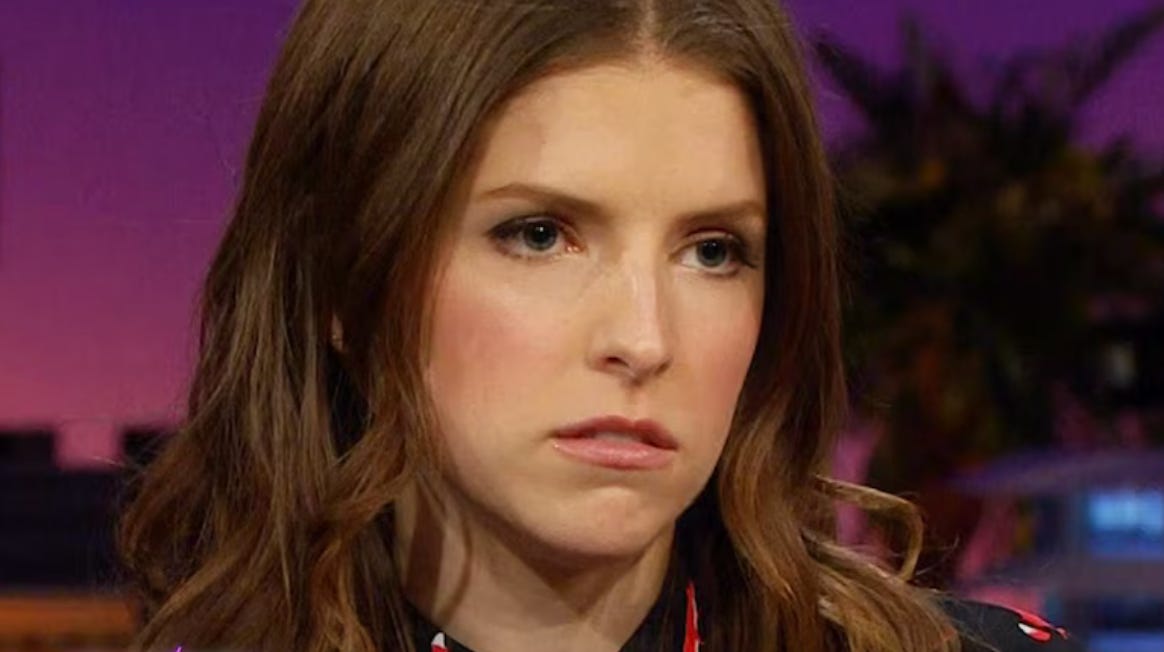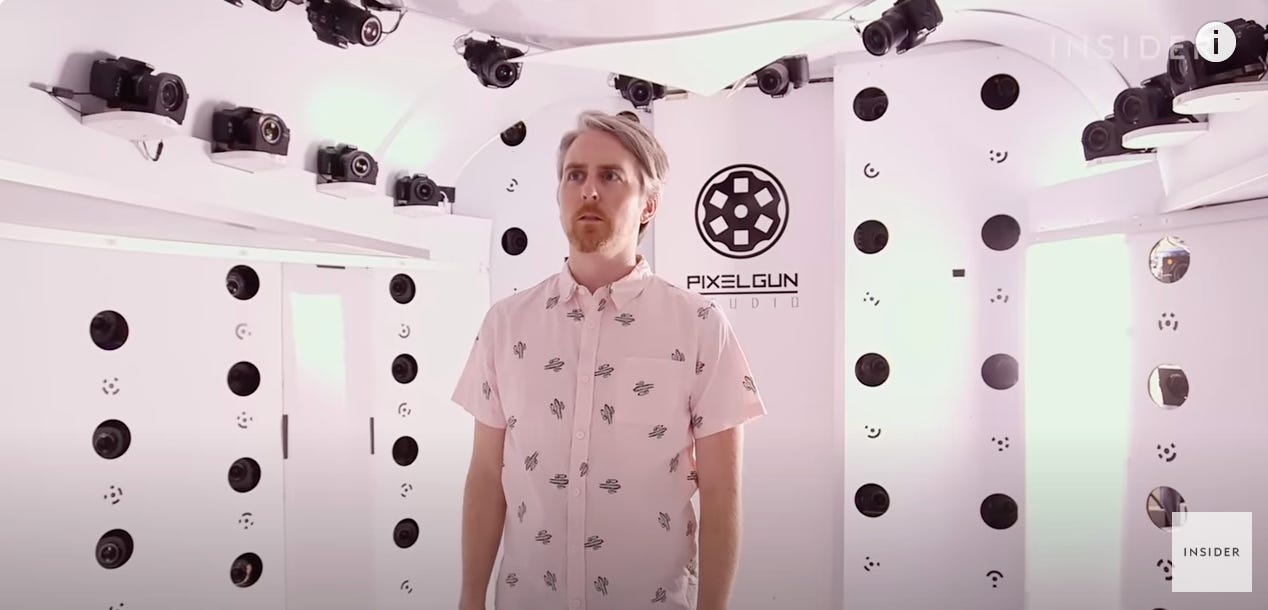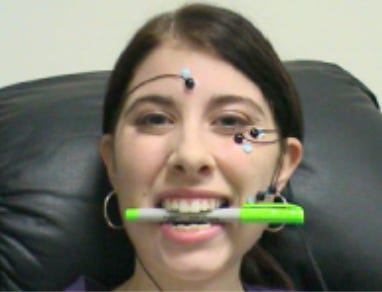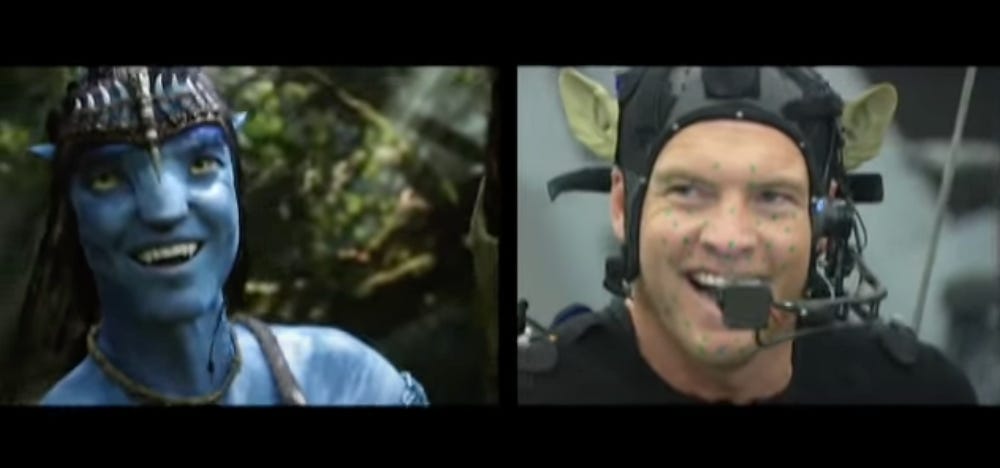Resting bitch face & the science of a smile
Leading to my smiling experiment and performance capture acting story
You know the expression “fake it ‘til you make it”? Well, when it comes to smiling, science proves it to be true. I’ll share more about that science and what happened when I tried a smiling experiment of my own.
First, this: have you heard of “resting bitch face”?
Resting bitch face can apply to any gender and describes when someone’s neutral and resting facial expression gives the appearance that they’re angry or unhappy. They’re not, but they appear that way because in their neutral state, their lips fall into a slight downturn and/or their brows are slightly furrowed. (Some celebrity examples would be Kristen Stewart, Leonardo DiCaprio, or Anna Kendrick, as shown below.)

I remember one time in a grocery store, many years ago. I was minding my own business, in no particular mood, when someone approached me in the aisle, saying “smile!” I looked up to see a guy looking at me. I gave him a quizzical look. “It can’t be that bad,” he said. “Smile! It’s a beautiful day!”
Nothing like feeling totally fine, then being accused of not feeling fine by some stranger, and then becoming irritated by that stranger, thereby proving that you are now, indeed, in any mood but a smiling one. What did he know about my day? It was obnoxious and bizarre and I had no idea what he was talking about (and told him so), but it did leave me wondering about my facial expression. Was it that bad? I know I’ve seen photos of myself holding a neutral expression, yet appearing intense and serious. Might I have a resting bitch face?
The science of a smile
Fast forward to recent years, when I was taking that fabulous course on the brain at Duke–the one I keep mentioning and will continue to reference in future posts because it was that fantastic.
Well, here’s another of the many factoids I learned in that class:
Scientific studies show that simply forming a smiling expression increases mental positivity. The muscle movement of your mouth triggers your mind to make a subconscious mood shift, correlating with the smile. (It’s like your mouth is tricking your brain.)
If you ever listened to, or read, author and life coach Tony Robbins, you’ll recall how he encourages you to put a smile on your face, no matter how you’re feeling, and just hold that expression until it turns real. I listened to his tapes in the early ‘90s and I remember thinking this was slightly silly until I tried it. It seemed to work. Was it just the power of suggestion? Was I buying into a theory that wasn’t factual?
It’s factual, alright. In one study, scientists at the University of South Australia asked participants to place a pen sideways between their teeth. Doing this simple action created a “covert smile”. They then studied what happened in their brains.
What they found was pretty cool:
“In our research we found that when you forcefully practice smiling, it stimulates the amygdala—the emotional center of the brain—which releases neurotransmitters to encourage an emotionally positive state. For mental health, this has interesting implications. If we can trick the brain into perceiving stimuli as ‘happy’, then we can potentially use this mechanism to help boost mental health . . . A ‘fake it ’til you make it’ approach could have more credit than we expect.”
–Lead researcher and human and artificial cognition expert, Dr. Fernando Marmolejo-Ramos (excerpt from Neuroscience News)
The professor of our Duke class also suggested that the more regularly you form a smile, the more likely you are to naturally start doing so.
I liked that idea, so I decided to try my own experiment: I would form a smile whenever it occurred to me. Not a big exaggerated smile, but a tiny one with the corners of my lips slightly raised. As with mindfulness practice, I would come back to the breath and the subtle smile. (Like the Buddha’s expression.) I would practice this on my daily walks and hikes. I would practice this while sitting at my computer. I would practice this when shopping at the grocery store. 😊
The science of a smile and my performance capture story
About a month after I started my little smiling experiment, I had the wonderful experience of being cast to do performance capture acting work for the NBA 2K22 video game. (I played various small roles.)
I will provide a basic description of what is involved with performance capture work, since 1) it’s interesting, I hope? and 2) it applies here. (Actors and producers, feel free to add any input, as this was my first time.)
Performance capture (Pcap) is different than motion capture (Mocap). In Mocap, they capture your body movements alone; in Pcap they also capture your facial expressions and your voice. For Pcap, you wear a body suit with sixty markers (reflective dots) and a special makeup artist places dot markers around your face. You then don a helmet contraption with a small self-facing camera attached to it, and are miked for audio.
Motion and performance capture work occur in a large space called “the volume,” which is surrounded on all sides by 280 cameras. As you move, the cameras track your markers via infrared light and triangulate the data for a 3D effect. This data is then used in post-production to create your image and movements for the screen.
Performance capture work also requires “mapping” your body and the way it moves, as well as your facial expressions, by triangulating the data from the markers on your body and face. They reference that data and utilize it during editing and post-production. For body mapping, they ask you to move your body into distinct physical positions, capturing your marker data for each one.
My facial mapping experience
For facial mapping, I went to a place near the production studio where they specialize in doing that. The facial mapping setup is inside a mobile trailer. This trailer has gone all over the country and has mapped virtually every NBA player.

Inside the trailer, I stepped further into an enclosed space (as shown above) surrounded by 144 cameras. I faced forward and the director watched my face through a tiny window. He started the facial mapping by asking me to rest my face in a neutral expression. He then explained that I’d be making a series of facial expressions, one by one, with his guidance. When he thought each expression was just right, I’d hold it until all cameras simultaneous went off in a huge FLASH, performing a 360-degree scan of that expression. After each expression, I would return to my neutral resting face. Then, we’d move on to the next.
I don’t recall the number of facial expressions I had to make, but there were a lot. From anger to surprise to disgust to joy and many more, with nuances in-between. Some expressions were exaggerated and severe.
After doing this for a while, my facial muscles started to tighten up, making it harder to form new expressions naturally. The director said this was typical and normal and told me to rest for a minute before we continued. Then he said, “your natural resting expression is a smile, which might make it more challenging.”
I laughed. Was he joking?
“My natural expression is a smile?” I asked in disbelief.
“Yeah,” he said matter-of-factly. I told him about my experiment and he laughed, “well, I guess it’s working, because that’s your natural resting expression.”
Ha!
Had my month of smile experimenting done the job? Or is it possible that my resting expression was simply prone to being a happier one that day? Maybe a little of both.
But I took that away with me. And though I eventually forgot to keep practicing the smile, I occasionally remember: oh yeah, smile. Practice, practice. Just a slight one. Like the Buddha.
It works. You might feel silly smiling for the sake of smiling, at first. In fact, you probably will. It feels forced and maybe a little dumb, and if you’re in public, you might feel a little self-conscious, but I’m telling you, it’s pretty cool. Hold it for a little while and it slips from deliberate to natural and real.
Why not practice putting a smile on your face whenever you think of it? What a simple thing to do. Just by moving your mouth muscles, you can raise your mood and bring positivity into that moment. And hey, who knows, it could even morph into your natural “resting” expression. Imagine that! 😊







Why, this is fabulous!! So much great information & I loved the account of your performance gig. I too apparently do not have resting bitch face, as people often comment in the fact that I am smiling as I walk down the street. & I don't think I am! The schmuck who told you to smile is a blight...I never understand why people do this. Thanks for another great piece!
I loved this. I am definitely going to run the smile experiment. Hugs to you, old friend!